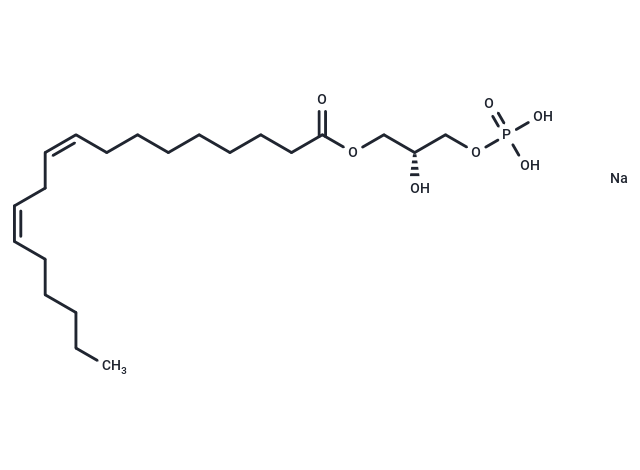- Remove All
 Your shopping cart is currently empty
Your shopping cart is currently empty
1-Linoleoyl Lysophosphatidic Acid sodium
1-Linoleoyl lysophosphatidic acid (1-linoleoyl LPA), a glycerophospholipid with linoleic acid at its sn-1 position, acts as an LPA2 receptor agonist and is the predominant LPA form in both mouse and human plasma. This compound preferentially boosts intracellular calcium in Sf9 cells expressing the LPA2 receptor (EC50 = ~10 nM), compared to those with LPA1 and LPA3 receptors (EC50s = ~200 and ~80 nM, respectively). Notably, 1-linoleoyl LPA serum concentrations are elevated in mice with NCTC clone 2472 tumors, while its plasma levels are reduced in primary progressive multiple sclerosis patients—unlike in those with relapsing-remitting multiple sclerosis—and inversely associate with the severity of neurological deficits.

1-Linoleoyl Lysophosphatidic Acid sodium
| Pack Size | Price | Availability | Quantity |
|---|---|---|---|
| 500 μg | Inquiry | 35 days | |
| 1 mg | Inquiry | 35 days |
Product Introduction
| Description | 1-Linoleoyl lysophosphatidic acid (1-linoleoyl LPA), a glycerophospholipid with linoleic acid at its sn-1 position, acts as an LPA2 receptor agonist and is the predominant LPA form in both mouse and human plasma. This compound preferentially boosts intracellular calcium in Sf9 cells expressing the LPA2 receptor (EC50 = ~10 nM), compared to those with LPA1 and LPA3 receptors (EC50s = ~200 and ~80 nM, respectively). Notably, 1-linoleoyl LPA serum concentrations are elevated in mice with NCTC clone 2472 tumors, while its plasma levels are reduced in primary progressive multiple sclerosis patients—unlike in those with relapsing-remitting multiple sclerosis—and inversely associate with the severity of neurological deficits. |
| Alias | PA(18:2/0:0), PA(18:2(9Z,12Z)/0:0), LPA(18:2), 1-Octadecadienoyl-2-hydroxy-sn-glycero-3-phosphate, 1-Octadecadienoyl-2-hydroxy-sn-glycero-3-PA, 1-Linoleoyl-2-hydroxy-sn-glycero-3-phosphate, 1-Linoleoyl-2-hydroxy-sn-glycero-3-PA, 1-Linoleoyl LPA, 18:2 Lyso PA |
| Molecular Weight | 434.50 |
| Formula | C21H39O7P.XNa |
| Cas No. | 72777-86-7 |
| Storage | keep away from moisture | Powder: -20°C for 3 years | In solvent: -80°C for 1 year | Shipping with blue ice. |
| Solubility Information | Methanol: Soluble Ethanol: Soluble |
Calculator
In Vivo Formulation Calculator (Clear solution)
Dose Conversion
Tech Support

Copyright © 2015-2025 TargetMol Chemicals Inc. All Rights Reserved.




